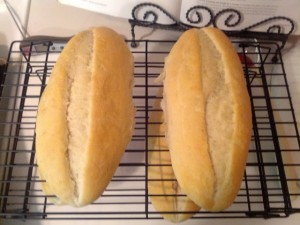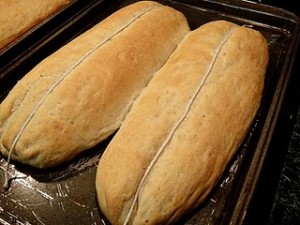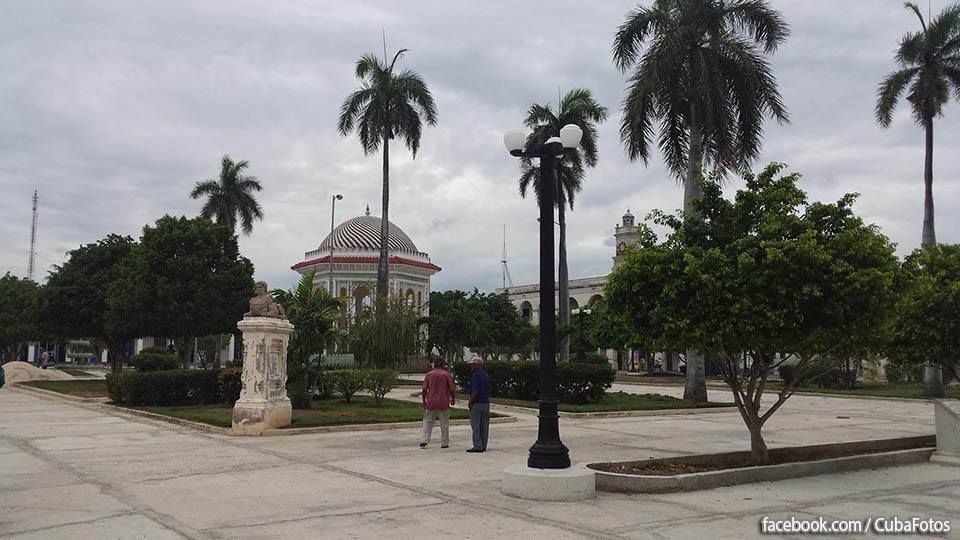CÓMO HACER UN “BUEN” PAN CUBANO.
Hornear pan es un arte.
Hornear pan, cualquier tipo de pan, es verdaderamente un arte. Hornear un pan perfecto calidad panadería de pan cubano es el logro final de cualquier panadero pan casero. En la superficie, pan cubano parece tan simple; consta de sólo cinco ingredientes principales: harina, agua, levadura, manteca de cerdo y sal.
El reto, sin embargo, está poniendo estos simples ingredientes juntos en la forma adecuada. El objetivo es crear un pan con una corteza crujiente por fuera y un lugar aireado, ligera textura en el interior.
La clave para la cocción de una gran hogaza de pan cubano está en saber exactamente la cantidad de harina que se utiliza para llevar la pasta a la consistencia perfecta. El exceso de harina y el pan serán demasiado denso. Demasiado poco de harina y la masa no subirán correctamente, lo que resulta en una gran hogaza plana de pan!
Si no te importa un desafío, la búsqueda de la perfecta rebanada de pan cubano puede ser muy gratificante.
Con una corteza crujiente en el exterior y una ligera textura en el interior, un pan caliente, recién horneado de pan cubano es la siguiente mejor cosa para el cielo.
Ingredientes:
Pre-fermentación (masa madre)
3/4 cucharadita de levadura (active dry yeast)
1/3 taza de agua tibia
1/3 taza de harina de pan (bread o all-purpose flour)
El dia antes de hacer el pan.. disuelva la levadura en el agua tibia. Luego agregas la harina y lo mezclas bien para formar una pasta. Lo cubres bien con plástico y lo guardas en la nevera por 24 horas.
Para la masa de pan:
4-1/2 cucharaditas de levadura ( o 2 sobres de active dry yeast)
1 cucharada de azúcar
1-1/2 tazas de agua tibia
3 a 4 cucharadas de manteca de cerdo o si prefieres, manteca vegetal, a temperatura
1/2 de la mezcla pre-fermentada, a temperatura
1 cucharada de sal
4 1/2 tazas de harina de pan (bread o all-purpose flour)
Disuelva la levadura en 3 cucharadas de agua tibia con el azúcar en un bowl de la maquina. Cuando la mezcla espume (5 a 10 minutos), le agregas la manteca, el resto del agua y la mitad de la masa madre que fué preparada el dia antes.
Usando el gancho de amasar, lo mezclas mientras que le Agregas 3 1/2 tazas de harina y la sal. Suba la maquina a velocidad 2 y lo amasas por 6 minutos (10 minutos si lo estas amasando a mano). La masa debe estar suave blanda y lisa, pero no pegajosa. Echa mas harina si es necesario para que no quede pegajosa la masa.
Engrasas un bowl con manteca vegetal y echas la bola de masa, dando una vuelta para que tenga una poca de manteca por encima. Cubra el bowl bien con plástico y lo dejas fermentar en un lugar tibio por 1 hora (debe doblar en tamaño). Retire la masa del bowl y sobre una mesa harinada, lo amasas por 1 minuto para sacarle los gases. Divida la masa en 3 porciones iguales y le das la forma a los panes, de 14 pulgadas de largo.
Usando 2 placas de hornear, le colocas los panes (a mi me gusta usar el silpat para esto). Los cubres con un paño limpio y lo dejas subir en un lugar tibio por 1 hora.
Pre-calienta el horno a 350 F. Usando la botella de spray, mojas las paredes del horno un poco. Despues de 1 minutos, vuelves a mojar las paredes para crear vapor en el horno..
Cuando vayas a echar los panes en el horno, usando la navaja, le haces un corte a lo largo de los panes, no muy profundo. Cueza los panes hasta que esté dorados y suenen huecos cuando le dés con el dedo, como 20 minutos.
Poga los panes cocidos sobre una parrilla a refrescarse por 1 hora antes de cortarlos (hay que tener mucha paciencia, porque huelen riquisimo).
El unico cambio que yo hice fue el de cocinarlos a 400F por 18 minutos y usar levadura instantanea.
Que los Disfruten!
Agencies/ThreeGuysfromMiami /Sonia Martinez/ Internet Photos / Arnoldo Varona/ thecubanhistory.com
THE CUBAN HISTORY, HOLLYWOOD.
HOW TO MAKE A “GOOD” CUBAN BREAD.
Baking Bread is an Art.
Baking bread, any kind of bread, is truly an art. Baking a perfect bakery-quality loaf of Cuban bread is the ultimate accomplishment for any home bread baker. On the surface, Cuban bread seems so simple; it consists of just five main ingredients: flour, water, yeast, lard, and salt.
The challenge, however, is putting these simple ingredients together in exactly the right way. The goal is to create a loaf with a crisp crust on the outside and an airy, lightly textured inside.
The key to baking a great loaf of Cuban bread is in knowing exactly how much flour to use to bring the dough to the perfect consistency. Too much flour, and the bread will be too dense. Too little flour, and the dough won’t rise properly, resulting in a very wide, flat loaf of bread!
If you don’t mind a challenge, the quest for that perfect loaf of Cuban bread can be very rewarding.
With a crisp crust on the outside and a lightly textured inside, a warm, fresh-baked loaf of Cuban bread is the next best thing to heaven.
INGREDIENTS:
1 tablespoon active dry yeast
2 teaspoons sugar
1 1/4 cups warm water
2 cups bread flour (see instructions)
2 cups all-purpose flour (see instructions)
2 teaspoons salt
1/4 cup lard (melted in microwave)
2 tablespoons warm water (to brush on loaves before baking)
Grease a large bowl, and set aside.
Take a small bowl and dissolve the yeast and sugar in 1/4 cup of warm (110 degrees F) water. Place the bowl in a warm place and let it stand until it starts to foam and double in volume, about 10 minutes. If it doesn’t foam and bubble, you have some bad yeast!
Meanwhile, measure out 1/4 cup of lard and place the lard in a Pyrex measuring cup or other suitable container. Heat in the microwave on high for about 90 seconds until melted.
Place the water/yeast/sugar mixture in the mixing bowl of a stand mixer. Add the rest of the warm water and the salt. Using the dough hook, mix on low speed until blended.
Take your measuring cup and dig in to the flour bag, scooping out two whole cups of each flour. Now the important part: in a separate bowl, sift together the two flours. Sifted flour has more volume than un-sifted flour, so you will use approximately 3 1/4 cups of sifted flour in the following steps.
Gradually add the flour mixture, a little at a time, to the wet ingredients in your mixer — mixing constantly. At the same time you are adding flour, gradually pour in the melted lard. Keep adding a little flour and a little lard until all of the lard is added.
Continue adding more flour — A LITTLE AT A TIME — until you make a smooth and pliable dough. Try to add just enough flour to make the dough elastic — just as much as necessary so that the dough hook barely cleans the sides of the bowl. Too much flour and your bread will be too dense! You will use approximately 3 1/4 cups of sifted flour to bring the dough to this point. (More or less, this is where the art of baking comes in!) Save any leftover flour mixture for rolling out the dough.
Now let the machine and the dough hook go to work kneading the dough. Set the mixer on a low speed and knead for about 3 to 4 minutes, no more! Your dough will be fairly sticky at this point.
NOTE: If you don’t have a mixer with a dough hook, you can also do this the old fashioned way. Turn the dough out onto a lightly floured surface. Pound the dough ball down and knead by hand until the dough is smooth and elastic, about ten minutes.
Shape the dough into a ball and place it into that bowl you originally greased in the first step of this recipe, what was that, something like a week ago now? We know, we know — bread making is a long and involved process!
Flip the dough ball a few times to grease it up on all sides. Cover the bowl with a damp cloth and place in a warm place. (We like to pre-heat our oven to 160 degrees F and then turn it off, thus creating a perfectly warm environment for our rising bread.) Let the dough rise until it doubles in size — about 45 minutes to 1 hour.
It’s at this point in the process that you can usually find three guys, covered in flour, sitting by the pool with their feet up and enjoying a cold beverage. It’s also about now when Raúl always asks, “Why didn’t we just pick up a loaf of bread at the bakery?”
When you return from the pool, turn the dough out onto a lightly floured board, using the leftover flour you have in the bowl. Sprinkle some flour on the dough and use a rolling pin to roll it out. We like to make a large loaf, shaped to fit our longest baking sheet diagonally — about 20 inches long. So we try to roll out a 12 x 20-inch rectangle. Sprinkle more flour on the dough and turn it over a few times as you roll it out, to keep it from sticking to the rolling pin. The added flour at this rolling stage should take care of most of the stickiness of the dough.
Roll the dough up into a tightly rolled long cylinder, with a slight taper at both ends. Wet your fingers and pinch the loose flap of the rolled dough into the loaf, making a tight seam.
Grease a baking sheet and sprinkle lightly with cornmeal.
Place the loaf diagonally onto the baking sheet, seam side down. Dust the top with a little extra flour and cover very loosely with plastic wrap. (You don’t want the rising dough to dry out or stick to the plastic wrap.)
Place in a warm spot and allow the loaf to stand and rise once again until it is about 2 1/2 times it’s original size, about 45 minutes to 1 hour. Cuban bread is wider than French bread, so expect your loaf to spread out quite a bit as it rises.
Preheat oven to 450º F. Place a pan of water on the lowest rack of the oven.
Use a sharp knife to cut a shallow seam down the middle of the top of the bread, leaving about two inches of uncut top on each end of the loaf.
Brush the top of the loaf with water and place in your preheated oven on the middle shelf. After about 5 minutes of baking, brush some more water on top of the bread.
Bake the loaf until it is light brown and crusty — about 12 to 18 minutes total baking time.
We all know that oven temperatures do vary — so keep an eye on it!
Que los disfruten !
Agencies/ThreeGuysfromMiami /Sonia Martinez/ Internet Photos / Arnoldo Varona/ thecubanhistory.com
THE CUBAN HISTORY, HOLLYWOOD.










